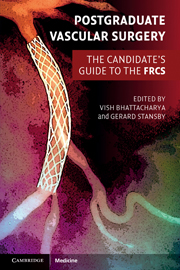Book contents
- Frontmatter
- Contents
- List of contributors
- Preface
- Section 1 Final FRCS vascular clinicals
- Section 2 Final FRCS vascular topics
- 1 Vascular risk factors and their management
- 2 Management of acute limb ischaemia
- 3 Chronic lower limb ischaemia, critical ischaemia and the diabetic foot
- 4 Endovascular and surgical options for peripheral revascularisation
- 5 Abdominal aortic aneurysms
- 6 Thoracic, thoracoabdominal and suprarenal aortic aneurysms
- 7 Aortic dissection
- 8 Popliteal artery aneurysms
- 9 Femoral artery aneurysms
- 10 Carotid, subclavian and vertebral disease
- 11 Diagnosis and management of thoracic outlet syndrome
- 12 Diagnosis and management of hyperhidrosis
- 13 Chronic mesenteric ischaemia
- 14 Acute ischaemic colitis
- 15 Vascular trauma
- 16 Indications and management of lower limb amputation
- 17 Leg swelling and lymphoedema
- 18 Varicose veins and chronic venous insufficiency
- 19 Management of deep vein thrombosis
- 20 Infection in vascular surgery
- 21 Vascular malformations
- 22 Vasospastic disorders and vasculitis
- 23 Critical care considerations and preoperative assessment for general and vascular surgery
- 24 Access surgery
- 25 Basic outline of solid organ transplantation
- Index
- References
2 - Management of acute limb ischaemia
- Frontmatter
- Contents
- List of contributors
- Preface
- Section 1 Final FRCS vascular clinicals
- Section 2 Final FRCS vascular topics
- 1 Vascular risk factors and their management
- 2 Management of acute limb ischaemia
- 3 Chronic lower limb ischaemia, critical ischaemia and the diabetic foot
- 4 Endovascular and surgical options for peripheral revascularisation
- 5 Abdominal aortic aneurysms
- 6 Thoracic, thoracoabdominal and suprarenal aortic aneurysms
- 7 Aortic dissection
- 8 Popliteal artery aneurysms
- 9 Femoral artery aneurysms
- 10 Carotid, subclavian and vertebral disease
- 11 Diagnosis and management of thoracic outlet syndrome
- 12 Diagnosis and management of hyperhidrosis
- 13 Chronic mesenteric ischaemia
- 14 Acute ischaemic colitis
- 15 Vascular trauma
- 16 Indications and management of lower limb amputation
- 17 Leg swelling and lymphoedema
- 18 Varicose veins and chronic venous insufficiency
- 19 Management of deep vein thrombosis
- 20 Infection in vascular surgery
- 21 Vascular malformations
- 22 Vasospastic disorders and vasculitis
- 23 Critical care considerations and preoperative assessment for general and vascular surgery
- 24 Access surgery
- 25 Basic outline of solid organ transplantation
- Index
- References
Summary
Key points
Acute limb ischaemia (ALI) is associated with significant mortality and morbidity
Clinical assessment is paramount for planning management
All cases of ALI should be assessed by a vascular specialist
All cases should be started on intravenous heparin as soon as possible to prevention extension of thrombus
Surgery is preferred with severe ALI as time is of the essence
Thrombolysis is associated with a lower mortality rate but higher failure rates
Surgery is more durable but is associated with a higher mortality rate
If compartment syndrome likely or suspected a fasciotomy is required
Definition
Acute limb ischaemia (ALI) can be defined as a sudden compromise of the blood supply to a limb, threatening its viability. Symptoms are usually of less than 2 weeks in duration. The lower limbs are more commonly affected than the upper limbs.
Background
Patients with ALI present depending on the severity of their symptoms. In patients with acute arterial occlusions and no collaterals symptom onset is immediate and severe. This scenario is seen in patients with embolic occlusions, trauma, thrombosed aneurysms and occluded grafts. If the acute event occurs with a background of an artery or a graft narrowing/occluding over a period of time then usually there are developed collaterals. In these patients the symptoms are often not as severe.
After 3–6 hours of severe ischaemia muscle and nerve undergo irreversible changes. Ischaemia of the limb for greater than 6 hours usually results in functional impairment or limb loss.
- Type
- Chapter
- Information
- Postgraduate Vascular SurgeryThe Candidate's Guide to the FRCS, pp. 49 - 57Publisher: Cambridge University PressPrint publication year: 2011



